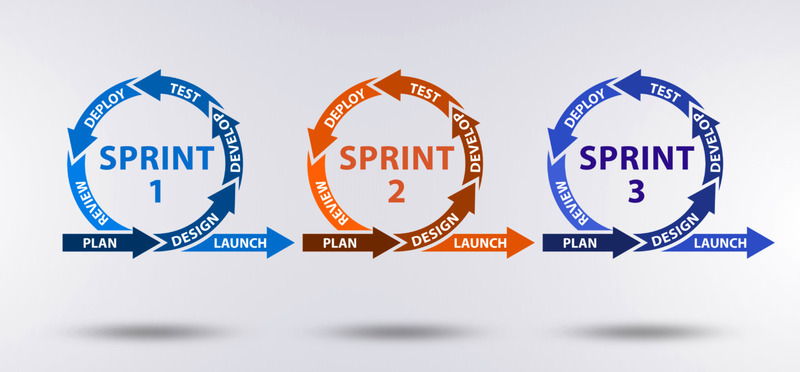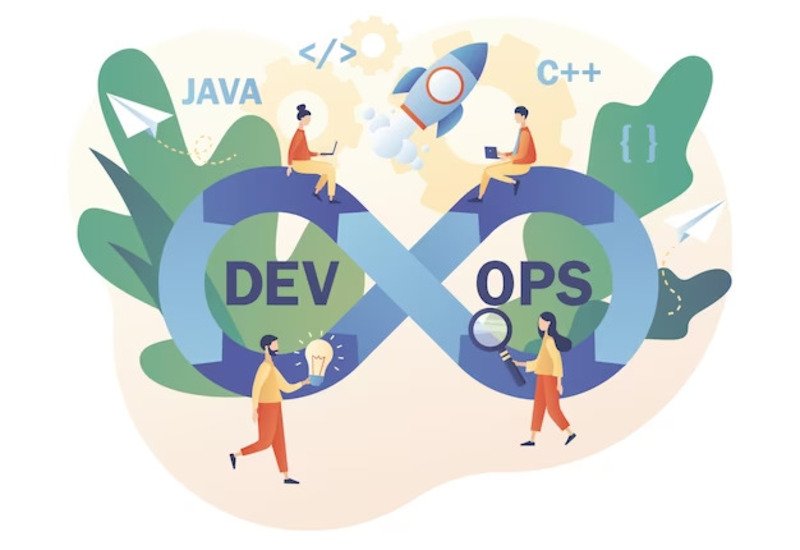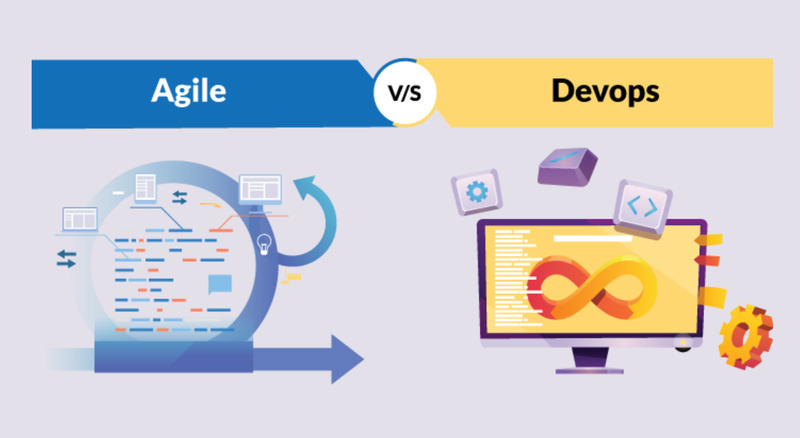The software and product development industries have shifted since Agile’s widespread adoption in the early 2000s. However, shortly after it became standard procedure, a major fault was discovered: the operations team, who delivered and maintained the software product, was overlooked, leaving a huge hole in the revolution.
As a result, the idea of DevOps emerged, which merges the functions of the development team with the operations team. So, can Agile be completely replaced by DevOps? Or do they work together? What is the difference between Agile vs DevOps? Learn more about the topic with Nexle Corporation here!
Definition of Agile vs DevOps
What is Agile?
Agile is a project management approach commonly used in software development. Its main objective is to break tasks into small segments and regularly review and adjust the strategy. Agile is a flexible method that helps address unexpected and unpredictable events by finding ways to adapt. It offers several benefits, the most significant being the ability to make real-time modifications if the software does not meet consumer requirements or expectations.
Agile is not a single development approach but a combination of different methodologies. It integrates Scrum, eXtreme Programming (XP), and other established techniques that developers have used for a long time. It emerged when practitioners brought together various methodologies to create a unified framework of principles. This collaborative effort resulted in the Agile manifesto, which includes 12 principles derived from four core values.

Agile projects are divided into “sprints” or “iterations,” which are timed, iterative periods of work
The Agile Manifesto encompasses four core Values:
- Working software over comprehensive documentation
- Responding to change by following a plan
- Individuals and interactions over processes and tools
- Customer collaboration over contract negotiation
What is DevOps?
DevOps is a collaborative process for designing, developing, testing, and releasing software efficiently and securely. It involves practices like automation, collaboration, rapid feedback, and iterative improvement by the teams responsible for creating and operating the software. These practices help speed up software distribution.
The DevOps method developed from the Agile method for software development. It’s a versatile approach to quickly and repeatedly build and release applications. Adopting the DevOps process will enhance your application’s workflow and improve collaboration throughout the development cycle, enabling people to work together more seamlessly.
DevOps thinking focuses on creating a collaborative and adaptable work environment. It emphasizes open communication and encourages interaction among team members, including developers, operators, and other stakeholders.

DevOps merges Dev and IT Ops to streamline processes, enhance collaboration, and generate high-quality software faster.
Similarities Between DevOps and Agile
Emphasis on Automation and Testing
Agile vs DevOps focus on achieving stability. Both approaches are effective in fast-paced, secure, and quality-driven environments. They achieve this by continuously and rigorously testing. As a result, they aim to build confidence in utilizing automation to enhance flexibility and security in the workplace.
Paves the way for Robust Partnerships
Despite their differences, both DevOps vs Agile convey a crucial message: create a collaborative environment where everyone communicates, identifies, and resolves problems swiftly. The interaction between team members and individuals is a crucial element in enhancing performance, productivity, and adaptability to change. Both approaches strive to establish a workplace where people collaborate, leading to innovation and triumph.

DevOps and Agile foster a collaborative atmosphere
An Inclination toward Business Output
DevOps and Agile are two methodologies that work together to achieve a common goal: increasing productivity. Both approaches prioritize delivering value to the company in a timely manner. Agile allows software development teams to focus on specific goals, freeing up resources and increasing output. Meanwhile, adopting a DevOps mindset enables faster releases and deliveries without disrupting corporate operations. This smart combination improves productivity while maintaining adaptability and efficiency.
Draws Inspiration from Lean Philosophies
DevOps and Agile have a common foundation rooted in the principles of Lean philosophy. They draw inspiration from Lean to streamline processes, enhance communication, and foster a productive and collaborative environment.
Difference Between Agile and DevOps
Agile and DevOps are two different approaches to developing software. Each methodology has its own techniques and objectives. Although there are similarities between them, their core goals and guiding principles are unique.
| Parameter | DevOps | Agile |
| Guiding Philosophy | In the DevOps culture, teams work together as one unit, combining tasks to achieve optimal results. This approach promotes cooperation among team members. | Agile methodology is a project management approach that enables teams to deliver improvements in small increments through iterative development cycles and continuous testing. |
| Focal Point & Purpose | Two foundational principles of the DevOps approach are continuous testing and rapid delivery. DevOps aims to streamline the entire technological and business process, emphasizing swift deployment from start to finish. | The primary objective of the Agile approach revolves around implementing continuous changes and gradually executing them after each development cycle, known as a sprint. Agile methodology is employed to handle complex projects effectively and enables flexibility in accommodating changes throughout the project’s execution. |
| Delivery and Deployment | In the process of delivery and deployment, DevOps utilizes pre-existing software that is readily available for release. The main emphasis is on ensuring secure deployments. | In contrast, Agile is responsible for building and creating software and managing the launch. However, it is not directly involved in deploying the software. |
| Team Size and Skills | In DevOps, collaboration among diverse teams is essential for success. By bringing together individuals with various skills and expertise, DevOps enables the sharing of responsibilities and ultimately leads to improved outcomes. | Agile emphasizes the importance of small teams working together to increase speed and reduce risk. In Agile, every team member becomes skilled at performing various tasks and becomes a versatile developer. |
| Delivery and Deployment | DevOps heavily relies on documentation. Detailed documentation is essential for effective teamwork, capturing processes, updates, information, and conversations. It plays a crucial role in facilitating collaboration and seamless communication among team members. | Agile embraces the idea that functional software is more valuable than extensive documentation. Therefore, documentation is approached in a way that promotes ease and flexibility in the collaborative development process. |
| Source of Feedback | In DevOps, it’s important to bridge the gap between developers and IT Operations and listen to their worries. Thus, feedback for improvements in speed and quality often comes from within the organization. | In Agile, special emphasis is placed on cutting the gap and addressing concerns between customers and development & testing teams. This means that the customer gives feedback, and changes are made based on what they say. |
| Means of Communication & Interaction | Communication in DevOps is conducted through technical and design documentation. | In Agile, the Scrum model is usually used. Communication is set up through daily scrum meetings and the sharing of information to talk about what needs to be done and how things are going with each task. |
Read more: DevOps vs DevSecOps: What’s the Difference?
Why Implement Agile vs DevOps Methodologies Together?
Implementing Agile can be challenging, especially if we’re unsure where to begin. Success lies in reaching the necessary standards in processes and attitudes for the Agile shift. Without Agile, software development becomes slow and inefficient. However, by integrating Agile vs DevOps, we can harness the benefits of Agile’s approach and the speed and efficiency of the DevOps method.

Implement Agile vs DevOps Methodologies Together
Things to Consider When Integrating Agile and DevOps:
- The project team needs to ensure effective interaction among its members. From the Scrum Master and Product Owner to the development team, operating team, and system administrator, everyone should be aware of the entire development process, including delivery, deployment, and maintenance. The project team needs to comprehensively understand delivery, service, change management, environmental management, automation, tools, and how to utilize them. The team has been focused on finding solutions to the challenges of Agile product development when transitioning to operations.
- For DevOps to function effectively within an Agile framework, it is important to establish the lifecycle of a product. This brings about consistency, eliminates waste, and accelerates product delivery, resulting in cost savings.
- Applying DevOps in each Sprint:
- Encourage active participation from operations, system administration, infrastructure, and support roles in sprint planning sessions.
- Discuss product features and identify features that can be operationalized.
- Incorporate the DevOps team into daily meetings, sprint reviews, and sprint retrospectives to ensure active participation.
- By adopting these methods, collaboration between development and operations teams improves, operationalizing features becomes more streamlined, and a holistic DevOps approach is encouraged in every sprint.
After implementing DevOps in a sprint, you can consider the following practices:
- Regarding DevOps, performance and load testing are essential, aligning with Agile’s principles. Emphasizing testing’s role in continuous project development, it stands comparable to the development itself.
- Using appropriate tools is one of the critical requirements for implementing Agile vs DevOps.
- Documentation/Capturing Essential Information.
- Streamlining these tasks enhances software integration and delivery, optimizing the development and operations process.
Read more: DevOps vs Developer: Understand Differences and Make Right Choices
DevOps vs Agile methodologies have distinct differences, but both share the common goal of increasing speed and producing high-quality software. This similarity forms the foundation of their collaboration. It is widely acknowledged that these two approaches cannot function independently, and separating them would result in an incomplete product development cycle. Agile methodologies and DevOps enhance the software development life cycle (SDLC) and contribute to the overall improvement of software products.
In today’s fast-paced world, the key to success lies in the ability of a product to adapt to new trends and circumstances. It is crucial for companies to quickly identify and respond to these changes by embracing innovative methods such as DevOps and Agile. These powerful technologies enable teams to overcome obstacles, improve software development processes, and ultimately deliver value to their users.
Did the article effectively clarify the similarities and distinctions between DevOps vs Agile? We eagerly await your thoughts! Share your feedback in the comments section below or connect with us on LinkedIn, Twitter, or Facebook. Your input is highly valuable to us, and we greatly appreciate it!


